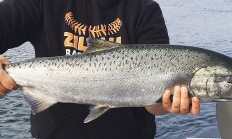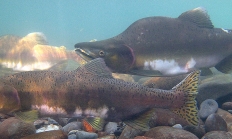Search myodfw.com
Features: Like all cutthroat trout, this species boasts bright red streaks on either side of its “throat.” You can tell it’s a westslope cutthroat by its spot pattern – the majority of the black spots are found on the back end of the fish with rather few ahead of the dorsal fin. Habitat: While westslope cutthroat trout was once the most widely distributed cutthroat in North America, its home in Oregon has always been limited to the John Day Basin. During the cooler months of summer you can find them in places like Strawberry Creek and upper Canyon Creek. As

Features: Coastal rainbow trout are often residualized steelhead that spend their entire life cycle in fresh water, never migrating to sea. They are a silvery color with black spots on their backs and fins, and a pink band running down their sides. Often their gill covers are pink as well. The pelvic anal, and dorsal fins have a white edge to them. Habitat: They can be found in cold rivers, creeks, and inland lakes. However, they require streams with clean gravel, complex habitat, and cool temperatures for spawning and rearing. Techniques: Trout in stillwaters tend to be on the move

Features: Tiger trout are a hybrid between a female brown trout and a male brook trout. They are greenish yellow to brown with dark patches along their sides creating a maze-like pattern. Their belly is yellowish orange and the tail fin is square. Habitat: These sterile fish have been introduced to Diamond and Fish lakes to help combat several invasive bait fish species. Since they do not reproduce, tiger trout are catch-and-release only. Techniques: Tiger trout will go for flies, spoons, spinners and bait. Because tiger trout are piscivorous (they eat other fish), fishing a minnow imitation can be effective.

Features: While in the ocean, Chinook salmon often have a purple hue to their backs with silvery sides and bellies, large oblong black spots on the back, and round black spots on both lobes of the tail (note that tail spotting may be obscured in ocean fish by “silver” in the tail). Upon returning to freshwater to spawn, Chinook darken in color and develop red on their bellies and fins. A key identifier is the black gum line on the lower jaw with dark colors both inside and outside of the gum line. Spawning generally occurs from August to early

Features: When in the ocean chum salmon are bluish green on their backs. Their tails lack spots but tend to have silver streaks like the coho. Their lower jaw will be dark at the gum line and white or pink both inside and outside of the gum line. Once in freshwater, chums become dark green to brown with red to purple marks going vertically down their sides. Habitat: Like other salmon species, chum spend most of their lives at sea and return to their natal streams to spawn. Most spawning runs are over a short distance. Adults are strong swimmers

Features: When in the ocean coho salmon can look very similar to Chinook salmon. However, coho will have a white gum line on the lower jaw with darker color both inside and outside of the gum line, and will only have spots on the upper lobe of their tails. When coho return to freshwater they become red on their sides and dark greenish on their backs, heads, and fins. Coho adults may reach 25 pounds or more, but rarely exceed 15 pounds. Habitat: Small, relatively low-gradient tributary streams with pea to orange-sized gravel for spawning and juvenile rearing. Coho may

Features: Kokanee are silvery in color until they are ready to spawn, at which time they become reddish. They do not grow as large as sockeye- their ocean traversing siblings. They can vary significantly in size depending on how densely populated the waterbody is. Since they are filter feeders, their populations can quickly expand and contract with the availability of food. Habitat: Kokanee can be found at all depths of cold, clear lakes and reservoirs in several parts of the state. They will change which depth they are at depending on water temperature. Technique: They are a challenging fish to

Features: These fish are silver when young, but darken and develop black spots on their tails and backs as they age. In fresh water, the males are red on their sides and develop a hump on their backs earning this species the common name humpback salmon. Females in fresh water are green on the sides with dark bars. Pink salmon are an average of 20- to 25-inches long and rarely weigh over 5 pounds. Habitat: Pink salmon spawn on odd numbered years and do so very close to saltwater, never going very far upriver. In fact, some pink salmon will

Features: Before spawning, sockeye salmon are silvery on their sides, white on their bellies, and dark blue on their backs. When spawning, their heads turn green with black on the snout and upper jaw, and their bodies turn red. They can be 24- to 33- inches long and weight between 5 and 15 pounds. Habitat: Many sockeye populations require a lake for part of their life cycle. Spawning may occur along lake shorelines or in stream gravels, but fry usually migrate to lake environments soon after emergence and occupy this habitat during their stay in fresh water. Technique: Sockeye salmon

Features: These fish are light silvery-white, dark on top, and have up to 8 dark, broken stripes running along the sides of their bodies. They are typically less than 10 lbs but can grow to 22 lbs. They have two dorsal fins, the front one with eight or nine spines and the rear one with one spine and 13 or 14 soft rays. Habitat: Hybrid bass were originally stocked in Tenmile Lakes on the south coast and in Ana Reservoir in Lake County. They have since been introduced into Thompson Reservoir, also in Lake County. The only established population is

Features: Largemouth bass are greenish on the back and sides with a white belly and usually a dark horizontal stripe along the side. They are distinguished from their close cousin, the smallmouth, by a large mouth with the upper jaw extending behind the eye. Largemouth bass in Oregon can exceed 25 inches in length and a weight of 12 pounds. Habitats: Their preferred habitats are shallow ponds and lakes, or the backwater sloughs of rivers where aquatic plants or submerged logs and brush provide abundant cover. Largemouth bass begin life feeding on zooplankton (tiny crustaceans), but soon switch to insects

Features: Smallmouth bass are golden green to bronze with dark vertical bars and blotches on the side. The upper jaw does not extend beyond the eye. In some locations, it has a red eye. Somewhat smaller than the largemouth, smallmouth bass in Oregon may reach 23-inches and exceed 7 pounds. Habitat: Smallmouth bass are adapted to flowing waters and do well in warm streams with deep holes and rocky ledges. They also prefer lakes and reservoirs with rocky shorelines and limited vegetation. Adult smallmouth feed mostly on fish and crayfish. Technique: Much of what was written about largemouth bass also

Features: They are dark olive on the tops of their bodies, silver on the sides, and white underneath, with 6-9 black stripes running horizontally from behind their heads to their tails. Habitat: Striped bass spend most of their time in fresh water, with occasional and unpredictable trips to the sea. Technique: In the spring and fall stripers are likely to be closer to the surface. During this time bait, such as dead minnows or night crawlers, will entice the fish to bite. During summer, the bass go deeper to escape the heat. This is the time to use flashy bait.

Features: Channel catfish are pale bluish-olive above and bluish-white below with a deeply forked tail, dorsal and pectoral spines, and an adipose fin. Like all other catfish, channel catfish have “whiskers” or barbels extending from the chin and upper jaw. Young fish have a varying number of small black spots over much of the body, while older fish may be partially or entirely without spots. Maximum size in Oregon approaches 40 pounds, but most are less than 10 pounds. Habitat: Channel catfish in western Oregon are limited to the Columbia River, lower Willamette River, and a few ponds in the

Features: White crappie are often confused with black crappie. White crappie have silvery bodies with blackish-green mottling forming narrow vertical bars on the sides. The forehead is more dished than in the black crappie. The dorsal fin has five or six spines and its length is less than the distance between the dorsal fin and eye. Habitat: White crappie do best in larger lakes and reservoirs and are more tolerant of turbidity and less dependent on aquatic vegetation than black crappie. They congregate around pilings, sunken logs, underwater brush, weed beds and rocks. White crappie begin life feeding primarily on

Features: Starry flounder are a flatfish with both eyes on the "top" side of their heads. They are dark on the eyed side with very rough scales, and alternating yellow/orange and black bands in the dorsal, anal, and tail fins. Habitat: Flounder tend to stay near the bottom, looking for food above. Technique: Drift a small jig or bait (such as shrimp, marine worm or mussel) on a #2 hook with 2-ounce sinker rigged on a 10- to 15-pound line over a sandy or muddy bottom. Header photo by Sam Grover, Flickr

Features: The Pacific sanddab is left-eyed, meaning both eyes are on the left side of the body. The eyed-side is dull light brown, mottled with brown or black, and sometimes yellow or orange. The blind-side is off-white to tan. They have an oval shaped body with large scales. They can grow to be 16-inches long and up to 2 pounds, though most weigh less than 1/3 pound. Habitat: As you probably guessed, sanddabs like to hang out on sandy bottoms. They are most abundant at depths of 20-50 fathoms, and are common in shallow coastal waters from British Columbia to
Features: Soles have flattened, oval bodies with both eyes on one side of their head. They are dark on top and light underneath. Habitat: They are commonly found on mud or sand bottoms from 5- to 750-fathoms deep. Techniques: Soles and other flatfish are best targeted by fishing with smaller hooks (less than 2/0) tipped with bait such as clam necks, sand shrimp, or chunks of herring or anchovy on a sandy or gravel bottom.

Features: The females are freckled all over with small reddish-brown to golden spots on gray to brownish background. Their fins are mostly yellowish-orange. The males are gray to brownish-olive, with irregular blue spots on the front of their bodies; each spot is surrounded by a ring of small reddish-brown spots. The inside of this species' mouths are yellowish. Habitat: Kelp greelings can be found to depths of 150 feet. They prefer rocky inshore areas and are common in kelp beds and on sand bottoms. Technique: It is best to target kelp greenlings by placing a line near the base of

Features: Usually greenish to brown with darker mottling, but most fish have bright red blotches on their sides. They tend to have dark bars or blotches on their fins, and the inside of their mouths are bluish. Habitat: Their habitat is subtidal algal beds and rocky reefs from the Bering Sea to southern California. Technique: Try fishing for rock greenlings from the shore as they are often captured in shallow, rocky areas. These fish have small mouths, so try a #4 or #6 hook to catch these daytime feeders.

